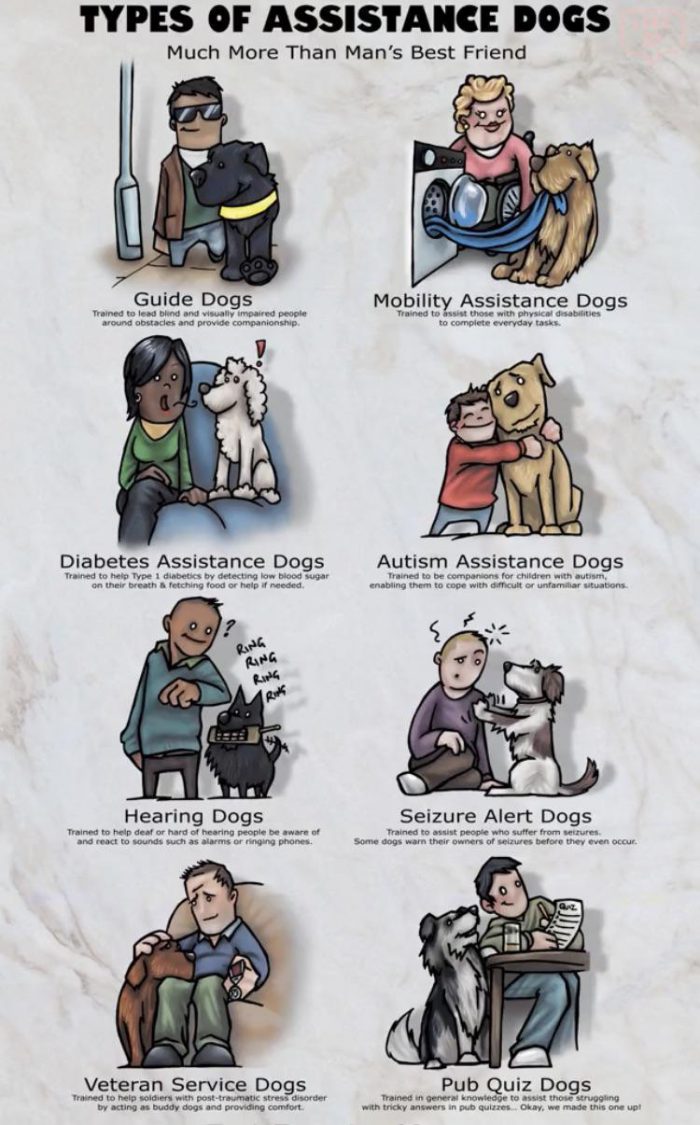
The next time you’re out and see someone with a dog, it may not be just any old pet. According to the Americans with Disabilities Act (ADA), service dogs are “any guide dog, signal dog, or other animal individually trained to provide assistance to an individual with a disability.” Service dogs can help those with a wide range of disabilities such as blindness or deafness—but some people who use them have even more unusual afflictions. So what types of service dogs are there? Here’s a list of eight common types (plus one weirder one).
Guide Dogs
Guide dogs are used by people who are blind or visually impaired. They can be trained to identify and guide their owner around obstacles, as well as help them navigate public transportation.
Mobility Assistance Dogs
A mobility assistance dog is trained to help people with disabilities to move around. These dogs can be trained to do things like open and close doors, pick up items, turn on lights and operate power switches. They may also be taught balance techniques such as placing their paws on a person’s leg or shoulder while they walk so that they can help stabilize them.
Diabetes Assistance Dogs
Diabetes Assistance Dogs (DADs) are trained to monitor their owner’s blood sugar levels and alert them when it is too high or too low. They can also help with tasks like opening doors, turning off lights and turning on appliances. The DAD program was developed by the University of Florida’s Diabetes Institute in 2002 after seeing a need for dogs that could assist people living with diabetes. The program trains dogs to recognize early signs of hypoglycemia (low blood sugar) and hyperglycemia (high blood sugar), alerting their owners so they can take action before the situation becomes dangerous.
Autism Assistance Dogs
Autism Assistance Dogs are trained to provide physical assistance, emotional support and social support. These dogs help children with autism communicate, play and learn in ways that they would not otherwise be able to do on their own. An Autism Assistance Dog can be trained to lie down next to its owner when something triggers anxiety or stress; this helps the person feel calmer while they work through whatever situation is causing them distress. In addition, some dogs will fetch items like medications or books for their owner if he or she has trouble getting around without assistance from others; other dogs may retrieve objects that were dropped during a tantrum (like food). Autism Assistance Dogs provide companionship as well as comfort when needed most–they’re always there for you!
Hearing Dogs
Hearing Dogs are trained to alert their owners to sounds such as a doorbell, smoke alarm and telephone. They can also be trained for other alerts such as baby crying or an alarm clock going off. Hearing Dogs can be any size, but are usually small enough that they can fit in the owner’s lap easily.
Seizure Alert Dogs
Seizure alert dogs are trained to detect an oncoming seizure and alert a handler before it happens. The dog alerts the handler by nudging or licking the handler, barking, or sitting next to the handler. This can give them time to get to safety and prevent injury during a seizure. A seizure alert dog may also be trained to retrieve objects that fall during an episode of non-convulsive status epilepticus (NCSE) so that they don’t injure themselves while being unable to move.
Veteran Service Dogs
Veterans with service dogs are able to return to their normal lives and enjoy their freedom, thanks to the help of their loyal companions. A veteran’s service dog can assist in many ways:
- PTSD (post-traumatic stress disorder)
- Anxiety and depression
- Mobility issues
Veteran Service Dogs are trained to help with hearing loss, mobility issues and more!
Service dogs are an amazing tool that can help people with disabilities live a more independent life. They provide companionship, comfort and safety for their owners. We hope this article has helped you understand the different types of service dogs as well as how they can help people with different conditions.
